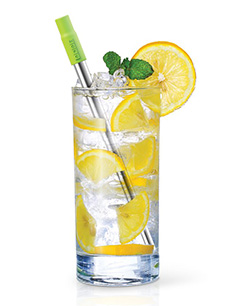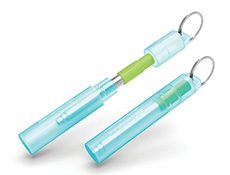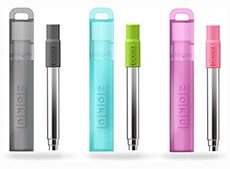STOCKING STUFFER: Zoku Pocket Straw & The History Of Straws
|
Americans use millions of plastic straws each day. Plastic drinking straws are among the top 10 contributors to marine debris pollution [source]. They are one of the top five contributors to plastic marine waste, with millions of plastic straws being used every day in the U.S. alone. During a five year cleanup project around American shorelines, nearly 7.5 million straws were found [source]. These non-biodegradable straws litter our streets, lands, shorelines, and oceans. They do not biodegrade but break down into smaller microplastics that have made their way into our food chain and the deepest trenches of our oceans. Coalitions of restaurants, bars, cafes, hotels, event venues and other organizations are committing to eliminate single-use plastic straws; but it will take time to trickle down. Environmentally-conscious consumers are aware of the problem, and strive to eliminate single-use plastics straws, sending them back in food venues and drinking straight from the glass. Numerous reusable straws have come onto the market to meet the demand. The one we like best is Zoku’s reusable stainless steel Pocket Straw. The right person will love it! And at $9.99, it doesn’b break the bank. You can buy it in Berry, Charcoal or Teal on the company website, or on Amazon, and at other retailers and e-tailers. From ancient times, man has had the need to sip from a straw. The first known straws were made by the Sumerians, living along the valleys of the Tigris and Euphrates rivers in the Fertile Crescent—the “birthplace of civilization”. It’s located in the historical region of southern Mesopotamia, modern-day southern Iraq*, dating to the 4th millennium B.C.E. [source]. Back in during the Chalcolithic (Copper Age) and Early Bronze Ages, necessity was the mother of invention. The straw was invented to drink ancient man’s favorite drink: beer. It is believed that the straws were needed to avoid the solid byproducts of fermentation that sank to the bottom of the vessel. |
|
|
|
The oldest drinking straw in existence, found in a Sumerian tomb dating to 3000 B.C.E., belonged to someone who could afford all the food and drink he liked. It’s a gold tube inlaid with lapis lazuli. These early straws weren’t the simple, practical straws we might imagine; they were elaborate, ceremonial objects that demonstrated wealth and status, ornate drinking tubes made from precious metals and decorated with semi-precious stones. These straws were likely used for drinking beer from communal vessels. Beer was a staple beverage in Sumerian society and the straws helped to filter out grain and other sediments at the bottom of the vessel. The idea caught on and natural grass straws were devised by and for ordinary people. Rye grass was particularly popular: hollow, naturally waterproof, and readily available. The did have the major drawbacks of affecting the taste of beverages and deteriorating quickly. Over the centuries, people created metal drinking straws from common metals, but metal was always expensive. American Marvin C. Stone patented the modern drinking straw, made of paper, in 1888. He did not enjoy sipping his Mint Julep through the rye grass straw, which not only became mushy, but imparted a grassy taste. One day, he wound paper around a pencil to make a long paper tube. Sliding the pencil from the paper, he applied glue to hold it together. The glue, too, would ultimately dissolve during slow sipping, so he later built a machine that coated the outside of the paper with wax to hold it together. Voilà: an improvement in sipping beverages that everyone could enjoy and afford. He mass-producing the paper straws, making them the first affordable and accessible to the general public. In 1937, Joseph Friedman invented the bendable straw after watching his young daughter struggle to drink a milkshake through a straight paper straw, too tall for her to reach easily. Friedman inserted a screw into a paper straw and wrapped dental floss around the grooves. When he removed the screw, it left accordion-like ridges that allowed the straw to bend. He patented his “Articulable Straw” that year. Manufacturers were not initially interested, but the straw eventually became widely popular, especially in hospitals where patients could drink while lying down. In 1969, his Flex-Straw Company was sold to the Maryland Cup Corporation. The 1950s saw the rise of the automobile and subsequently, the rise of Fast Food. These restaurants replaced washable plates, utensils, and glassware with low cost and portable paper for meals and drinks on the go. The transition to plastic straws happened gradually during the 1960s as the manufacturing infrastructure to mass produce plastic straws was put into place. While plastic was more costly than paper, it was cheap enough; and the straws didn’t lose their shape when saturated in liquid, as paper straws could. Existing straw manufacturers like Maryland Cup Corporation began producing them, and there was a bonus to both manufacturers and consumers: With the growth of fast food and to-go drinks, plastic straws could easily be pushed between the “X” crosshairs of a to-go lid without tearing. Better venues opted for plastic straws as a customer convenience. The consumer boom and the baby boom after World War II also gave rise to children-pleasing novelty straws: Good news going forward: Since the drinking straw issue has arisen, some paper straw manufacturers have created a thicker version of the paper straw. It holds up like plastic; and when it’s outlived its single-purpose use, it biodegrades. And cornstarch-based straws are on the rise, compostable and biodegradable. In 2024, plastic straws make up about 99% of the $3 billion global drinking-straw market. Some sources indicate that the category is growing at a CAGR of 20.27%. That’s a long way to go, but you can start now. ________________ *Other almost-as-old civilizations include Ancient Egypt, Norte Chico in Peru, and the Indus Valley in modern-day northwest India and Pakistan. The history of plastic straw bans [source]: CHECK OUT WHAT’S HAPPENING ON OUR HOME PAGE, THENIBBLE.COM. |
||







